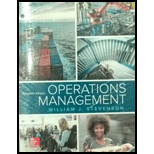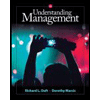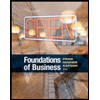
Concept explainers
a)
To compute: The labor productivity and multifactor productivity for each unit.
Introduction: Labor productivity is the measure of productivity of a worker during a period of time. It the ratio of total output to the total productivity hours.
a)
Answer to Problem 7P
Explanation of Solution
Given information:
| Unit | Employees | Customer processed/day |
| A | 4 | 36 |
| B | 5 | 40 |
| C | 8 | 60 |
| D | 3 | 20 |
Formula:
Calculation of multifactor productivity:
| Unit | Employees | Customer processed/day | Labor cost | Overhead cost | Material cost | Total cost | Labor productivity | MFP (2decimal) | MFP (3decimal) |
| A | 4 | 36 | 800 | 800 | 180 | 1780 | 9 | 0.02 | 0.020 |
| B | 5 | 40 | 1000 | 1000 | 200 | 2200 | 8 | 0.02 | 0.018 |
| C | 8 | 60 | 1600 | 1600 | 300 | 3500 | 7.5 | 0.02 | 0.017 |
| D | 3 | 20 | 600 | 600 | 100 | 1300 | 6.6666667 | 0.02 | 0.015 |
Table 1
Excel Worksheet:

Calculation of multifactor productivity:
Unit A:
Labor cost is calculated by multiplying number of workers (4) with 8working hours and 25 hourly wages which gives 800.
Overhead cost is calculated by multiplying Labor cost of 800 with 1.0 which gives 800.
Material cost is calculated by multiplying 36 with 5 which gives 180.
Total cost is calculated by adding labor cost of 800, overhead cost of 800 and material cost of 180 which yields 1780.
Labor productivity is calculated by dividing 36 with 4 which yields 9.
Multifactor productivity is calculated by dividing 36 with the total cost of 1,780 which yields 0.02 (2-decimal) and 0.020 (3 decimal).
Same procedure is followed for unit B, C and D the result is shown in table 1.
Hence, multifactor productivity has dropped from 0.020 to 0.015.
b)
To compute: The labor productivity and multifactor productivity for each unit.
Introduction: Multifactor productivity is also referred as total factor productivity. It is the measure of economic performance by comparing the amount of goods and services produced to the total input used to produce the output.
b)
Answer to Problem 7P
Explanation of Solution
Given information:
Every employee process on additional customers.
| Unit | Employees | Customer processed/day |
| A | 4 | 40 |
| B | 5 | 45 |
| C | 8 | 68 |
| D | 3 | 23 |
Formula:
Calculation of multifactor productivity:
| Unit | Employees | Customer processed/day | Labor cost | Overhead cost | Material cost | Total cost | Labor productivity | MFP (2decimal) | MFP (3decimal) |
| A | 4 | 40 | 800 | 800 | 200 | 1800 | 10 | 0.02 | 0.022 |
| B | 5 | 45 | 1000 | 1000 | 225 | 2225 | 9 | 0.02 | 0.020 |
| C | 8 | 68 | 1600 | 1600 | 340 | 3540 | 8.5 | 0.02 | 0.019 |
| D | 3 | 23 | 600 | 600 | 115 | 1315 | 7.6666667 | 0.02 | 0.017 |
Table 2
Excel Worksheet:

Calculation of multifactor productivity:
Unit A:
Labor cost is calculated by multiplying number of workers (4) with 8 working hours and 25 hourly wages which gives 800.
Overhead cost is calculated by multiplying Labor cost of 800 with 1.0 which gives 800.
Material cost is calculated by multiplying 40 with 5 which gives 200.
Total cost is calculated by adding labor cost of 800, overhead cost of 800 and material cost of 200 which yields 1800.
Labor productivity is calculated by dividing 40 with 4 which yields 10.
Multifactor productivity is calculated by dividing 40 with the total cost of 1,800 which yields 0.02 (2-decimal) and 0.022 (3 decimal).
Same procedure is followed for unit B, C and D the result is shown in table 2.
Hence, multifactor productivity has dropped from 0.022to 0.017.
Want to see more full solutions like this?
Chapter 2 Solutions
Loose Leaf for Operations Management (The Mcgraw-hill Series in Operations and Decision Sciences)
- PepsiCo South Africa says the incident where a woman discovered part of a rodent in her loaf of bread, is anisolated occurrence.Durban woman, Nombulelo Mkumla, took to social media last week to share how she discovered the rodent.In a lengthy Facebook post, she said she purchased the loaf of bread from a local shop after work on August 27.For the next days, Mkumla proceeded to use slices of bread from the load to make toast."Then, on the morning of August 31, I took the bread out of the fridge to make toast and noticed something disgusting andscary. I took a picture and sent it to my friends, and one of them said, 'Yi mpuku leyo tshomi' [That's a rat friend]“."I was in denial and suggested it might be something else, but the rat scenario made sense - it's possible the rat got into thebread at the factory, and no one noticed," Mkumla said.She went back to the shop she'd bought the bread from and was told to lay a complaint directly with the supplier.She sent an email with a video and…arrow_forwardPepsiCo South Africa says the incident where a woman discovered part of a rodent in her loaf of bread, is anisolated occurrence.Durban woman, Nombulelo Mkumla, took to social media last week to share how she discovered the rodent.In a lengthy Facebook post, she said she purchased the loaf of bread from a local shop after work on August 27.For the next days, Mkumla proceeded to use slices of bread from the load to make toast."Then, on the morning of August 31, I took the bread out of the fridge to make toast and noticed something disgusting andscary. I took a picture and sent it to my friends, and one of them said, 'Yi mpuku leyo tshomi' [That's a rat friend]“."I was in denial and suggested it might be something else, but the rat scenario made sense - it's possible the rat got into thebread at the factory, and no one noticed," Mkumla said.She went back to the shop she'd bought the bread from and was told to lay a complaint directly with the supplier.She sent an email with a video and…arrow_forwardThe deaths are included in the discharges; this includes deaths occurring in less than 48 hours and postoperative deaths. Rehabilitation had 362 discharges, 22 deaths, 1<48 hours, 0 Postoperative. what is the gross death rate for the rehabilitation service?arrow_forward
- A copy machine is available 24 hours a day. On a typical day, the machine produces 100 jobs. Each job takes about 3 minutes on the machine, 2 minutes of which is processing time and 1 minute is setup time (logging in, defining the job). About 20 percent of the jobs need to be reworked, in which case the setup time and the processing time have to be repeated. The remainder of the time, the equipment is idle. What is the OEE of the equipment?arrow_forwardHow do you think we can keep updating Toyota's ideas as new technologies come out and what customers want keeps changing?arrow_forwardGiven how TPS has helped change things in so many fields, do you think there are parts of it that might be hard to use in areas that aren’t about making things, like in healthcare or services? If so, why do you think that might be?arrow_forward
- Do you feel there is anything positive about rework?arrow_forwardDo you think technology can achieve faster setup times? How would it be implemented in the hospital workforce?arrow_forwardIn your experience or opinion, do you think process changes like organizing workspaces make a bigger difference, or is investing in technology usually the better solution for faster setups?arrow_forward
- Have you seen rework done in your business, and what was done to prevent that from occurring again?arrow_forwardResearch a company different than case studies examined and search the internet and find an example of a business that had to rework a process. How was the organization affected to rework a process in order to restore a good flow unit? Did rework hurt a process or improve the organization's operational efficiency? • Note: Include a reference with supportive citations in the discussion reply in your post.arrow_forwardSetup time is very important in affecting a process and the capacity of a process. How do you reduce setup time? Give examples of reducing setup time. Please Provide a referenecearrow_forward
 Practical Management ScienceOperations ManagementISBN:9781337406659Author:WINSTON, Wayne L.Publisher:Cengage,
Practical Management ScienceOperations ManagementISBN:9781337406659Author:WINSTON, Wayne L.Publisher:Cengage, Management, Loose-Leaf VersionManagementISBN:9781305969308Author:Richard L. DaftPublisher:South-Western College Pub
Management, Loose-Leaf VersionManagementISBN:9781305969308Author:Richard L. DaftPublisher:South-Western College Pub Understanding Management (MindTap Course List)ManagementISBN:9781305502215Author:Richard L. Daft, Dorothy MarcicPublisher:Cengage Learning
Understanding Management (MindTap Course List)ManagementISBN:9781305502215Author:Richard L. Daft, Dorothy MarcicPublisher:Cengage Learning Foundations of Business (MindTap Course List)MarketingISBN:9781337386920Author:William M. Pride, Robert J. Hughes, Jack R. KapoorPublisher:Cengage Learning
Foundations of Business (MindTap Course List)MarketingISBN:9781337386920Author:William M. Pride, Robert J. Hughes, Jack R. KapoorPublisher:Cengage Learning




